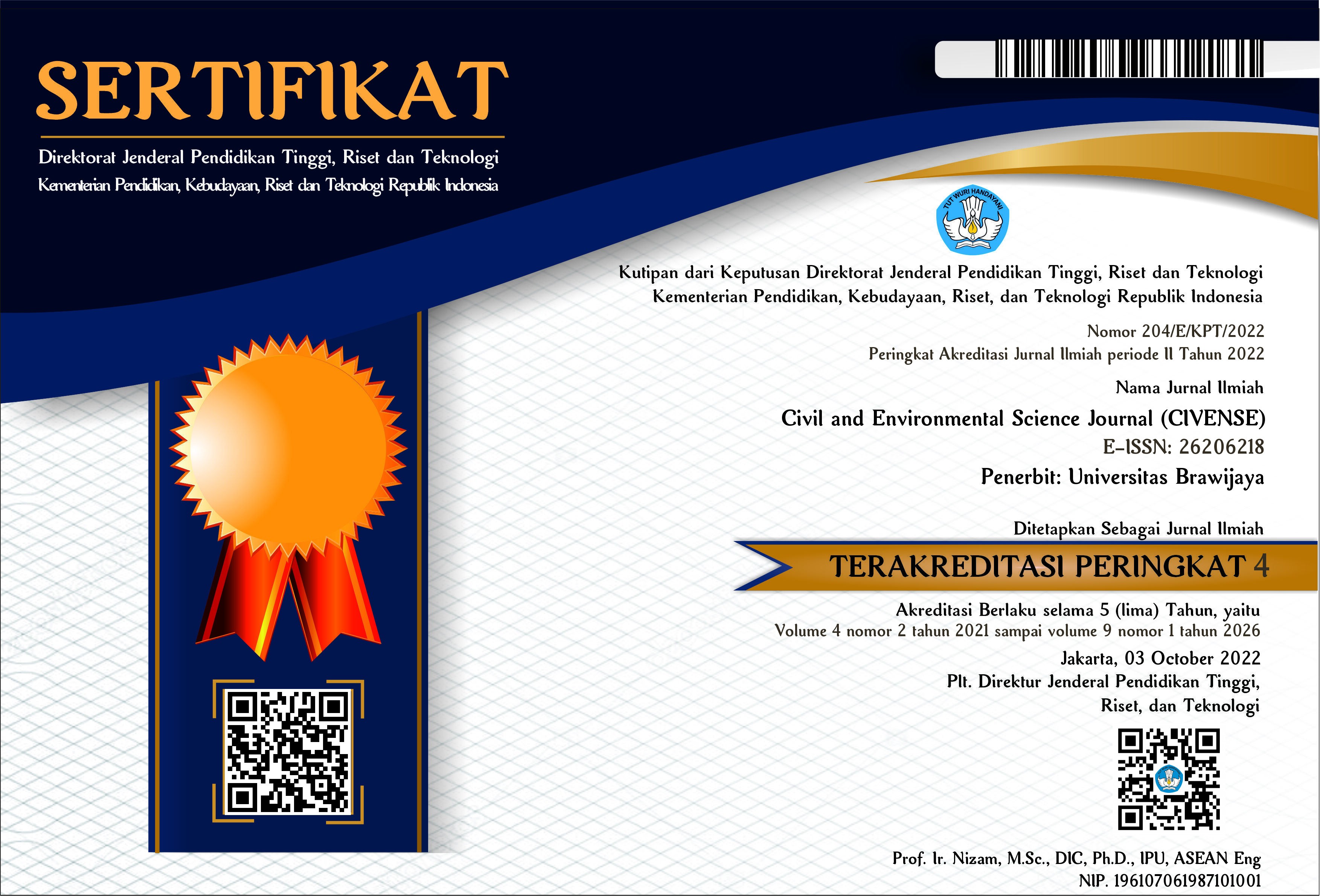Hydraulic Performance of Concrete Block Pavement under High Rainfall Intensities
DOI:
https://doi.org/10.21776/ub.civense.2019.00201.3Keywords:
Low impact development, sustainable urban drainage system, source control, storm water management, paving blocks, roughness coefficientAbstract
High rainfall intensity will generate different response on the concrete block pavement (CBP) performance. A study found that larger openings of CBP did not lead more water penetrated. In other study, larger openings can lead greater decrease in runoff velocity. The correlation between the openings, water penetration and runoff velocity has remained unclear. In this study, we investigated hydraulic performance of CBP as an impact of surface roughness condition, under high rainfall intensities, saturated sub-base layer, and various slope surfaces. We conducted experiment using a 2 m by 6 m of rectangular CBP layer with herringbone 90 and basket-weave pattern. We used a modified dye tracing method in view to monitor the surface flow velocity under various high rainfall intensities. The results showed that hydraulic performance of surface runoff in the CBP layer was more influenced by the surface roughness condition. The roughness condition was very sensitive to the change in surface configuration of the CBP. The relationship between rainfall intensity, surface slope and roughness number followed polynomial functions. A further study is required to investigate the appropriate quality of CBPs, which have high durability applied over a steep slope surface and under high rainfall intensities.
References
K. A. Collins, W. F. Hunt, and J. M. Hathaway, “Hydrologic comparison of four types of permeable pavement and standard asphalt in eastern North Carolina,” J. Hydrol. Eng., vol. 13, no. 12, pp. 1146–1157, 2008.
L. Sedyowati, S. Suhardjono, E. Suhartanto, and M. Sholichin, “Runoff velocity behaviour on smooth pavement and paving blocks surfaces measured by a tilted plot,” J. Water Land Dev., vol. 33, no. 1, pp. 149–156, 2017.
R. E. Horton, “The role of infiltration in the hydrologic cycle,” Eos Trans. Am. Geophys. Union, vol. 14, no. 1, pp. 446–460, 1933.
S. Pagliara, R. Das, and I. Carnacina, “Flow resistance in large-scale roughness condition,” Can. J. Civ. Eng., vol. 35, no. 11, pp. 1285–1293, 2008.
E. T. Engman, “Roughness coefficients for routing surface runoff,” J. Irrig. Drain. Eng., vol. 112, no. 1, pp. 39–53, 1986.
F. Darboux, P. Davy, C. Gascuel-Odoux, and C. Huang, “Evolution of soil surface roughness and flowpath connectivity in overland flow experiments,” Catena, vol. 46, no. 2, pp. 125–139, 2002.
J. U. Eitel, C. J. Williams, L. A. Vierling, O. Z. Al-Hamdan, and F. B. Pierson, “Suitability of terrestrial laser scanning for studying surface roughness effects on concentrated flow erosion processes in rangelands,” Catena, vol. 87, no. 3, pp. 398–407, 2011.
S. Jomaa et al., “Rain splash soil erosion estimation in the presence of rock fragments,” Catena, vol. 92, pp. 38–48, 2012.
S. C. Medeiros, S. C. Hagen, and J. F. Weishampel, “Comparison of floodplain surface roughness parameters derived from land cover data and field measurements,” J. Hydrol., vol. 452, pp. 139–149, 2012.
C. Mügler et al., “Comparison of roughness models to simulate overland flow and tracer transport experiments under simulated rainfall at plot scale,” J. Hydrol., vol. 402, no. 1, pp. 25–40, 2011.
M. W. Smith, N. J. Cox, and L. J. Bracken, “Terrestrial laser scanning soil surfaces: a field methodology to examine soil surface roughness and overland flow hydraulics,” Hydrol. Process., vol. 25, no. 6, pp. 842–860, 2011.
C. F. Izzard and W. I. Hicks, “Hydraulics of runoff from developed surfaces,” in Highway Research Board Proceedings, 1947, vol. 26.
J. R. Morgali and R. K. Linsley, “Computer analysis of overland flow,” J. Hydraul. Div., vol. 91, no. 3, pp. 81–100, 1965.
L. Sedyowati, Model Waktu Aliran Berdasarkan Model Faktor Retardasi Aliran Pada Permukaan Paving Blok. Digital Library University of Brawijaya, 2017.
L. Sedyowati and E. I. Susanti, “Effects of Concrete Block Pavement on Flow Retardation Factor,” J. Appl. Eng. Sci., vol. 7, no. 1, pp. 28–36, 2017.
Downloads
Published
How to Cite
Issue
Section
License
Copyright (c) 2019 Civil and Environmental Science Journal

This work is licensed under a Creative Commons Attribution-NonCommercial 4.0 International License.
Authors who publish with this journal agree to the following terms:
Authors retain copyright and grant the journal right of first publication with the work simultaneously licensed under a Attribution-NonCommercial 4.0 International License that allows others to share the work with an acknowledgement of the work's authorship and initial publication in this journal.
Authors are able to enter into separate, additional contractual arrangements for the non-exclusive distribution of the journal's published version of the work (e.g., post it to an institutional repository or publish it in a book), with an acknowledgement of its initial publication in this journal.
Authors are permitted and encouraged to post their work online (e.g., in institutional repositories or on their website) prior to and during the submission process, as it can lead to productive exchanges, as well as earlier and greater citation of published work (See the Effect of Open Access).














